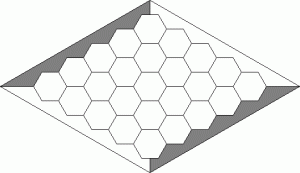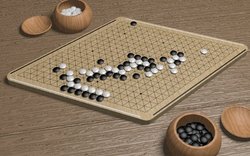For the next few weeks we will be exploring Game Theory. What is Game Theory? I have been reading a book by Rick Gilman, Models of Conflict and Cooperation. You can read the first several pages on Google Books. According to Gilman, Game Theory is the study of the mathematics of decision making. And since in Games, we need to make decisions every turn, it leads to great mathematical models, which can be applied to all realms of our daily lives which involve the decision making process. One of the great minds of Game Theory was John Forbes Nash, who actually received the Nobel Prize in Economics in 1994 for his work in Game Theory. For the parents, I strongly recommend the movie, A Beautiful Mind, which will give you some background into Nash’s life. The movie is PG-13, so I don’t think I would show it to 3rd graders, but it will give you a Hollywood version of what we are doing in Math Circle over the next few weeks.
John Nash invented in 1949 a game called HEX, which is what we played on our first day of class. I like the Hex Wiki sight because they have downloadable boards which you can print at home so you can play HEX at home. And if the students want to really refine their skills, they can play against the computer on the MazeWorks site. To learn the game, we played some medium sized boards.
HEX consists of hexagons arranged in a rhombas. Players take turns trying to make a path across the boards. Once the students were familiar with the rules of the game, we analyzed heuristics and strategies for the game. We spent some time discussing the 2×2 board. Under the guidance of Gilman, I named the two players Firstus and Secondus. Firstus tries to go from one white side to the other. Secondus tries to go from one black side to the other. Many of the students assumed that Firstus would always win the 2×2 game. But after further investigation, we realized the Secondus could win the game. So I had four questions for the students (taken from Gilman)
1. Can Firstus Win? How or why not?
2. Can Secondus Win? How or why not?
3. Can Firstus ensure a Win? How or why not?
4. Can Secondus ensure a Win? How or why not?
After playing the 3×3 version of the game, I asked the students to think about these questions for homework. Can they develop a Winning strategy for the 3×3 game? I am sure they can.
I also gave them some 4×4 boards, and 5×5 boards. I asked them to try and devise a winning strategy for these games. This is a bit challenging and would take some time.
What is a strategy? A strategy would be the complete set of possible moves which will guarantee the win. So this is much more complex than a heuristic, which would be for only one move.
So please have fun playing HEX with your children. Not only is it a fun game, there is some interesting mathematics behind it. In he coming few weeks I hope to study the Keypad Problem and the Game of Nim.
We had a reporter from the Daily Free Press visiting us today, so we might see some photos of the students in the local.
If you child gets really into HEX, there are versions of the game available. and instructions on the HEX Wiki site on how to build boards.




